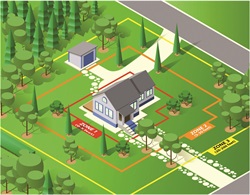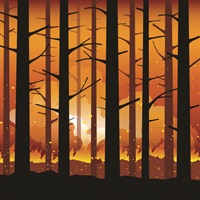Create Defensible Space

Defensible space is the area around your home in which vegetation, debris, and other combustible fuels have been removed to slow the spread of fire to and from the home. It prevents vegetation from igniting due to direct flame contact and spreading to your home. Defensible space is essential to help protect a structure and create a safer area for firefighters during a wildland fire. You should create defensible space by removing weeds, brush, and firewood, and by spacing out vegetation around your property. Although this might seem like a daunting task, we recommend starting in Zone 1 and working your way out. Follow the considerations below for each zone and your property can become safer with each step.
ZONE 1
0-5 feet around your home or to property line
-
Use hard scape such as concrete or noncombustible rock mulch around your home.
-
Clean roofs and gutters of dead leaves, debris, and pine needles.
-
Store firewood and other combustible materials away from your home, garage, or attached deck.
-
Prune away touching or over-hanging branches from the roof to a distance of at least 10 feet.
-
Replace or repair any loose or missing shingles or roof tiles to prevent ember penetration.
-
Rake and remove flammable vegetation, such as leaves and needles or wood mulch, from underneath your deck and away from your home.
-
Use non-wood, low-growing herbaceous vegetation. Succulents, or other fire-resistant plants, are recommended choices.
ZONE 2
5-30 feet around your home or to property line
-
5-30 feet around your home or to property line
-
Create vegetation groups or islands to break up continuous fuels around your home.
-
Remove ladder fuels to create a separation between low-level vegetation and tree canopies to keep fire from climbing into trees.
-
Remove leaf and needle debris from the yard.
-
Keep lawns, native grasses, and wildflowers less than four inches in height.
-
Store firewood and other combustible materials away from outbuildings such as a shed or barn.
-
Move trailers, recreational vehicles, storage sheds, and other combustible structures out of this zone and into Zone 3. If unable to move, create defensible space around them as if they were a part of your home.
ZONE 3
30-200 feet around your home or to property line
-
Create and maintain a minimum of 10 feet between the tops of trees.
-
Safely remove ladder fuels up to a height of 10 feet, while retaining at least 75 percent of the foliage, to create separation between the ground and tree branches. This keeps fire from climbing into the tree canopies.
-
Store firewood in this area, keeping it a safe distance from your structure.
-
Create space between shrubs and trees to eliminate a continuous fuel bed at the ground level.
-
Remove dead trees, shrubs, and all other dead or dry vegetation.
-
Create separation between your property and your neighbors. Consider that your trees may pose a greater risk to your neighbor’s home than to your own.
Zone 2 and 3
Remember the Ember Zone Embers
Embers are burning pieces of airborne material that can be carried more than a mile by the wind.
Research points to embers and small flames as the main ways homes ignite in wildland fires.
Reference: